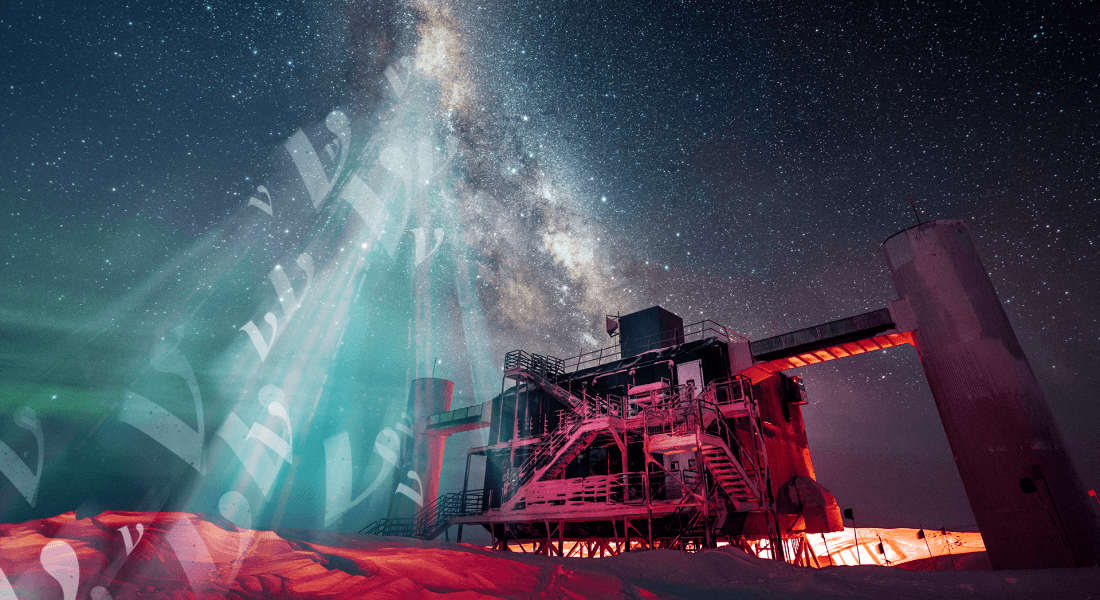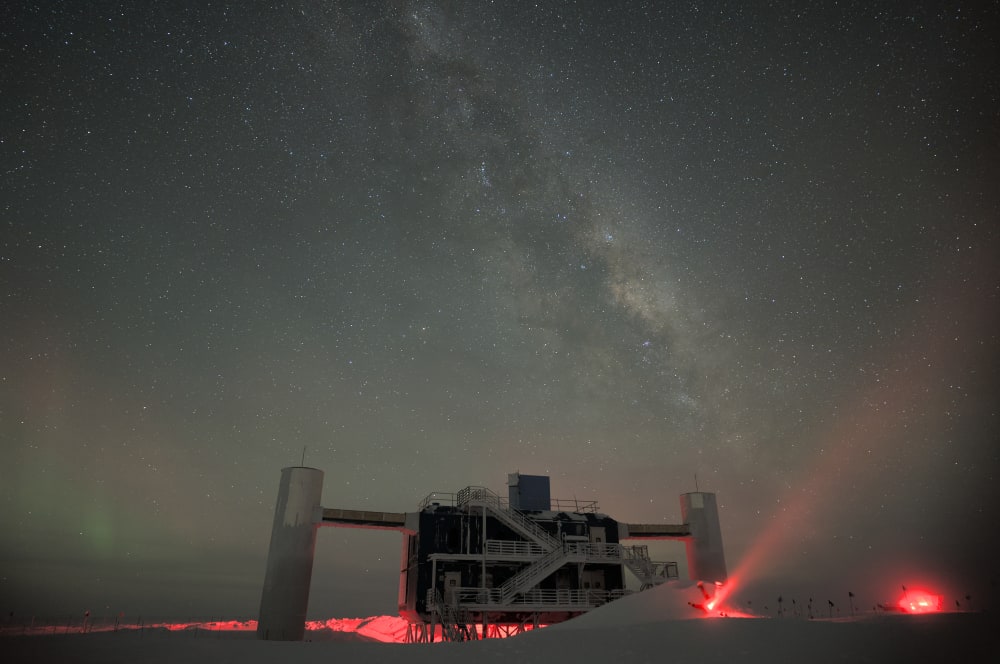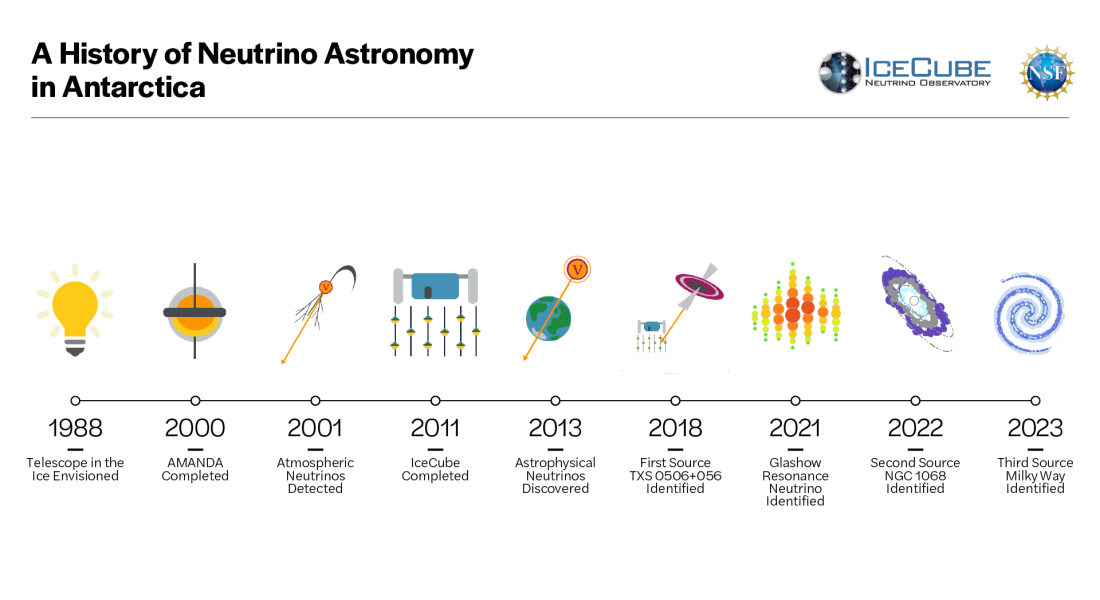The Milky Way through neutrino eyes
Our Milky Way galaxy is an awe-inspiring feature of the night sky, viewable with the naked eye as a horizon-to-horizon hazy band of stars. Now, for the first time, the IceCube Neutrino Observatory has produced an image of the Milky Way using neutrinos. In an article published in the journal Science, the IceCube Collaboration presents evidence of high-energy neutrino emission from the local galaxy.

Interactions between cosmic rays - high-energy protons and heavier nuclei, also produced in our galaxy - and galactic gas and dust inevitably produce both gamma rays and neutrinos. Given the observation of gamma rays from the galactic plane, the Milky Way was expected to be a source of high-energy neutrinos.
The search focused on the southern sky, where the bulk of neutrino emission from the galactic plane is expected near the center of our galaxy. However, until now, the background of muons and neutrinos produced within the Earth’s atmosphere posed significant challenges.
This is the first time we see our own galaxy in neutrinos, and we are investigating the possibility that galactic neutrino sources might hide in the emission
To overcome them, a recent analysis led by Steve Sclafani (Drexel University) and Mirco Hünnefeld (TU Dortmund) used "cascade" events - neutrino interactions in the ice that result in roughly spherical showers of light - with a reduced contamination of background atmospheric neutrinos and muons. The dataset included 60,000 total neutrinos spanning 10 years of IceCube data, 30 times as many events as the selection used in a previous analysis. The final breakthrough came from the implementation of machine learning methods that improved the identification of cascades produced by neutrinos as well as their direction and energy reconstruction.

"Neutrino emission from the Milky Way provides an entirely new probe of galactic cosmic rays," says Markus Ahlers, Assistant Professor at the Niels Bohr Institute and IceCube researcher. "In combination with cosmic-ray and gamma-ray data, we can now further scrutinize our theoretical models of cosmic ray acceleration, propagation, and interaction."
"The strong evidence for the Milky Way as a source of high-energy neutrinos has survived rigorous tests by the collaboration," says Ignacio Taboada, a professor of physics at the Georgia Institute of Technology and IceCube spokesperson. "Now the next step is to identify specific sources within the galaxy."
These and other questions will be addressed in planned follow-up analyses by IceCube.
In close collaboration with the Astroparticle Physics group at the Niels Bohr Institute, IceCube researchers are already exploring further implications of this result. "This is the first time we see our own galaxy in neutrinos, and we are investigating the possibility that galactic neutrino sources might hide in the emission," says Kathrine Mørch Groth, PhD student at the Niels Bohr Institute and IceCube researcher.
“This galactic neutrino observation illustrates the scientific power of combining modern machine learning techniques and state-of-the-art physics and astronomy detectors,” says Jason Koskinen, Associate Professor and leader of the IceCube research group at the Niels Bohr Institute. “The addition of upgraded sensors for IceCube in 2025/26 and new machine learning applications being developed at the NBI, we are excited about the next chapter for neutrino-based astrophysics and particle physics with IceCube.”

The detection of the second source of high-energy neutrinos and cosmic rays is the result of over 30 years of scientific exploration, with continuous support from the National Science Foundation (NSF) since the 1990s. Credit: IceCube/NSF
Article in Science: “Observation of high-energy neutrinos from the Galactic plane,” The IceCube Collaboration: R. Abbasi et al., Science 380, 6652 (2023), DOI:10.1126/science.adc9818.
Contact
D. Jason Koskinen, Associate Professor
Niels Bohr Institute, University of Copenhagen
Phone: +45 21 28 90 61
Email: koskinen@nbi.ku.dk
Markus Ahlers, Assistant Professor
Niels Bohr Institute, University of Copenhagen
Phone: +45 35 32 80 89
Email: markus.ahlers@nbi.ku.dk
